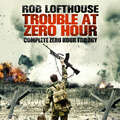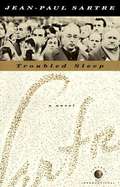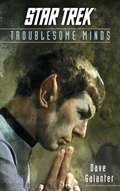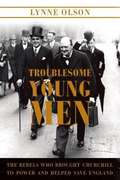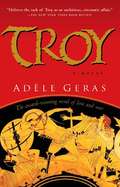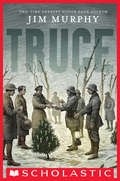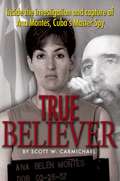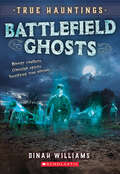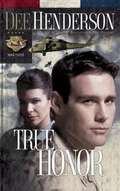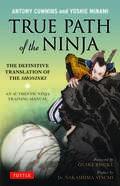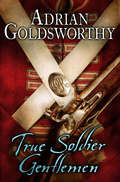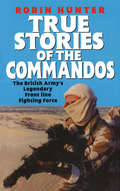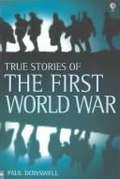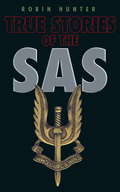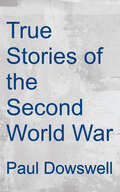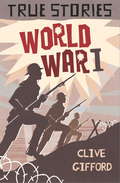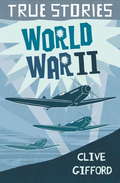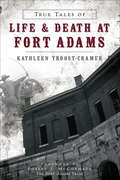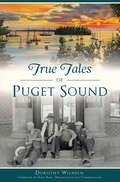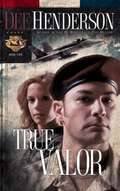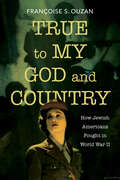- Table View
- List View
Trouble at Zero Hour: Complete Zero Hour Trilogy (Zero Hour Trilogy)
by Rob LofthouseWritten by a retired British soldier, Trouble at Zero Hour is a breathless and vivid story, dramatizing three of the key Allied operations that turned the tide of the Second World War.6 June, 1944, somewhere over the Normandy coastline: Robbie Stokes sits in a glider, his Bren resting on the floor between his outstretched legs. The nose lowers and the glider descends rapidly: ten minutes of stomach-churning twists and turns until suddenly the call goes up to 'BRACE'. The belly makes contact with the ground and the first Allied troops tumble out into occupied Europe.For new recruit Robbie Stokes it is the beginning of ten months of brutal and relentless conflict that take him from D-Day, via Operation Market Garden and the battle for Arnhem Bridge, to the Rhine Crossing and the final push for victory. Three operations that change the course of the war and test Robbie Stokes and his band of brothers to their limits. If they fail, then the Allied invasion fails. They must succeed through their longest days.(P)2019 Quercus Editions Limited
Trouble in Big Timber: A Cowboy Suspense Romance
by B.J. DanielsFrom New York Times bestselling author B. J. Daniels He&’s back at Cardwell Ranchto find a killer.Ford Cardwell is shocked when his college crush calls him out of the blue—even more so when he hears a gunshot. But when he joins forces with medical examiner Henrietta &“Hitch&” Rogers, she makes him wonder if the random call was a setup—not a murder. Together, they&’ll need to discover the truth, but looking into the case will put them in the sights of a killer.For more action-packed stories, check out the other books in the Cardwell Ranch: Montana Legacy series by B.J. Daniels: Book 1: Steel Resolve Book 2: Iron Will Book 3: Ambush before Sunrise Book 4: Double Action Deputy Book 5: Trouble in Big Timber Book 6: Cold Case at Cardwell Ranch
Troubled Sleep
by Jean-Paul Sartre Gerard HopkinsOriginally published in France as Les Chemins de la Liberte III: La Mort Dans L'Ame in 1949, and translated from the French by Gerard Hopkins, 'Troubled Sleep' powerfully depicts the fall of France in 1940, and the anguished response of the French people to the German occupation.
Troublesome Minds (Star Trek: The Original Series)
by Dave GalanterA thrilling Star Trek novel starring Kirk, Spock, and the crew of the Enterprise.While exploring the unmapped frontier, the U.S.S. Enterprise responds to a distress call from an unknown ship. Captain James T. Kirk turns first contact into a threat of interstellar war—by saving the life of a man his own people abandoned. Berlis, colony leader of a telepathic race calling themselves the Isitri, claims not to know why those from his homeworld want him dead. Now Kirk must either find a way to wrench billions from the grip of one man, or be responsible for the destruction of two planets.
Troublesome Young Men: The Rebels Who Brought Churchill to Power and Helped Save England
by Lynne OlsonA riveting history of the daring politicians who challenged the disastrous policies of the British government on the eve of World War II. On May 7, 1940, the House of Commons began perhaps the most crucial debate in British parliamentary history. On its outcome hung the future of Prime Minister Neville Chamberlain's government and also of Britain indeed, perhaps, the world. Troublesome Young Men is Lynne Olson's fascinating account of how a small group of rebellious Tory MPs defied the Chamberlain government's defeatist policies that aimed to appease Europe's tyrants and eventually forced the prime minister's resignation. Some historians dismiss the "phony war" that preceded this turning point --from September 1939, when Britain and France declared war on Germany, to May 1940, when Winston Churchill became prime minister--as a time of waiting and inaction, but Olson makes no such mistake, and describes in dramatic detail the public unrest that spread through Britain then, as people realized how poorly prepared the nation was to confront Hitler, how their basic civil liberties were being jeopardized, and also that there were intrepid politicians willing to risk political suicide to spearhead the opposition to Chamberlain --Harold Macmillan, Robert Boothby, Leo Amery, Ronald Cartland, and Lord Robert Cranborne among them. The political and personal dramas that played out in Parliament and in the nation as Britain faced the threat of fascism virtually on its own are extraordinary --and, in Olson's hands, downright inspiring.
Troy
by Adèle GerasTold from the point of view of the women of Troy, this portrays the last weeks of the Trojan War, when women are sick of tending the wounded, men are tired of fighting, and bored gods and goddesses find ways to stir things up.
Truce: The Day the Soldiers Stopped Fighting
by Jim MurphyOn July 29, 1914, the world's peace was shattered as the artillery of the Austro-Hungarian Empire began shelling the troops of the country to its south. What followed was like a row of falling dominoes as one European country after another rushed to war. Soon most of Europe was fighting in this calamitous war that could have been avoided. This was, of course, World War I. But who could have guessed that on December 25 the troops would openly defy their commanding officers by stopping the fighting and having a spontaneous celebration of Christmas with their enemies? In what can only be described as a miracle, this beautiful and heart rending narrative will remind everyone how brotherhood and love for one another reach far beyond the boundaries of war and politics.
True Believer
by Scott CarmichaelAna Montes appeared to be a model employee of the Defense Intelligence Agency (DIA). Known to her coworkers as the Queen of Cuba, she was an overachiever who advanced quickly through the ranks of Latin American specialists to become the intelligence community's top analyst on Cuban affairs. But throughout her sixteen-year career at DIA, Montes sent Castro some of America's most closely guarded secrets and at the same time influenced what the United States thought it knew about Cuba. When she was finally arrested in September 2001, she became the most senior American intelligence official ever accused of operating as a Cuban spy from within the federal government. Unrepentant as she serves out her time in a federal prison in Texas, Montes remains the only member of the intelligence community ever convicted of espionage on behalf of the Cuban government.This inside account of the investigation that led to her arrest was written by Scott W. Carmichael, the DIA's senior counterintelligence investigator who persuaded the FBI to delve deeper into Montes activities. Although Montes did not fit the FBI's profile of a spy and easily managed to defeat the agency's polygraph exam, Carmichael became suspicious of her activities and, with the FBI, over a period of several years developed a solid case against her. Here he tells the story of that long and ultimately successful spy hunt. Carmichael reveals the details of their efforts to bring her to justice, offering readers a front-row seat for the first major U.S. espionage case of the twenty-first century. She was arrested less than twenty-four hours before learning details of the U.S. plan to invade Afghanistan post-September 11. Motivated by ideology and not money, Montes was one of the last "true believers" of the Communist era. Because her arrest came just ten days after 9/11, it went largely unnoticed by the American public. This book calls attention to the grave damage Montes inflicted on U.S. security--Carmichael even implicates her in the death of a Green Beret fighting Cuban-backed insurgent in El Salvador and the damage she would have continued to inflict had she not been caught.
True Believer: The Terminal List, True Believer, And Savage Son (Terminal List #2)
by Jack Carr**SOON TO BE A TV SERIES STARRING CHRIS PRATT** 'This is seriously good… the suspense is unrelenting, and the tradecraft is so authentic the government will probably ban it – so read it while you can!' Lee ChildA high-intensity roller-coaster ride, True Believer explodes with action and authenticity that cements Jack Carr as the new leader in political thrillers. Following his brutal quest for revenge, former Navy SEAL James Reece has fled the United States, emerging deep in the wilds of Mozambique. But he can&’t stay hidden for long – when a string of horrific terrorist attacks plagues the Western world, the CIA tracks him down and recruits him. Now a reluctant tool of the United States government, Reece must travel the globe, targeting terrorist leaders and unravelling a geopolitical conspiracy that will have worldwide repercussions . . .If you loved Lee Child's Jack Reacher, Vince Flynn's Mitch Rapp or Mark Dawson's John Milton, you will love True Believer and the James Reece series!Praise for Jack Carr and the James Reece series: 'With a particular line in authentic tradecraft, this fabulously unrelenting thrill-ride was a struggle to put down' Mark Dawson 'Gritty, raw and brilliant!' Tom Marcus &‘So powerful, so pulse-pounding, so well-written—rarely do you read a debut novel this damn good&’ Brad Thor 'With technical ferocity and devastating action sequences, Carr writes both from the gut and a seemingly infinite reservoir of knowledge in the methods of human combat. Loved it!' Chris Hauty &‘The best debut thriller of 2018&’ Washington Times 'Thrilling' Publishers Weekly 'A powerful, thoughtful, realistic, at times terrifying thriller that I could not put down. A terrific addition to the genre, Jack Carr and his alter-ego protagonist, James Reece, continue to blow me away' Mark Greaney 'One of this year&’s hottest thrillers, and a perfect fit for fans of Vince Flynn, Brad Thor, and Daniel Silva' The Real Book Spy
True Hauntings #2: Battlefield Ghosts
by Dinah WilliamsChilling tales of vicious battle . . . and vengeful spirits.A bloody soldier who disappears into thin air. Flickering orbs floating over a military cemetery.History is filled with brave fighters cut down in the heat of battle. But what if they aren't resting in peace?True Hauntings: Battlefield Ghosts revisits deadly clashes from the past and the ghosts they left behind, from a headless horseman galloping through the night to restless spirits rising from sunken ships, searching for revenge.In this second volume of haunted history, find out how true stories can be some of the most terrifying of all.
True Honor (Uncommon Heroes #3)
by Dee HendersonFor CIA officer Darcy St. James, the terrorist attack on America is personal: Friends died at the Pentagon. She's after a man who knew September 11 would happen and who chose to profit from the knowledge. Navy SEAL Sam "Cougar" Houston is busy: The intelligence Darcy is generating has his team deploying around the world. Under the pressure of war, they discover the sweetness of love, and their romance flourishes. But it may be a short relationship -- for the terrorists have chosen their next targets, and Darcy's name is high on the list ...
True Path of the Ninja: The Definitive Translation of the Shoninki (An Authentic Ninja Training Manual)
by Yoshie Minami Anthony Cummins Nakashima Atsumi Otake RisukeTrue Path of the Ninja is the first authoritative translation in English of the Shoninki--the famous 17th century ninjutsu manual. Antony Cummins and Yoshie Minami worked closely with Dr. Nakashima Atsumi, author of the most comprehensive modern Japanese version of the Shoninki, thus making this English translation the closest to the original scrolls. <P><P>The information and insights found in this translation are invaluable for understanding the skills, techniques and mentality of the historical shinobi. Whether it involved tips for surviving in the wild, advice on intelligence-gathering techniques, or methods for creating chaos in the enemy camp, this ninja book unveils secrets long lost. Along with its practical applications, this book is an important guide to the mental discipline that ninjas must have to ensure success in accomplishing their mission.In addition to the translation of the Shoninki, this book also includes the first written record of the oral tradition "Defense Against a Ninja" taught by Otake Risuke, the revered sensei of the legendary Katori Shinto Ryu school of swordsmanship. Sensei reveals for the first time these ancient and traditional teachings on how the samurai can protect himself from the cunning wiles of a ninja.
True Soldier Gentlemen (The Napoleonic Wars #1)
by Adrian Goldsworthy Dr Adrian Goldsworthy Ltd'[A] Jane Austen-meets-Bernard Cornwell novel' Daily MailRaw recruits march under the summer sun. But on distant shores a terrible event is about to sing its siren's song to the true soldier gentlemen of Britain. For it is 1808, and the Peninsular War is about to erupt . . .Meet the men of the 106th Foot, a new regiment staffed by young gentlemen who know nothing of war. William Hanley is in the army because he has no other livelihood. Hamish Williams, a man without money or influence, is hoping war will make his name. Their friend Billy Pringle believes the rigours of combat will keep him from the drinking and womanising that are his undoing. And for George Wickham, battle is simply another means of social climbing.When the band of four are plunged into a savage war against the veteran armies of Napoleon, they find their illusions shattered and their lives changed for ever as they face the brutality of the battlefield . . . Combining the vivid detail of a master historian with the engaging characters and pulsating action of a natural storyteller, True Soldier Gentlemen is perfect for fans of Bernard Cornwell, Patrick O'Brian, C.S. Forester, Allan Mallinson and Simon Scarrow.*********************'It's so well written, flows so well, that the detail does not drag you down . . . a fantastic read, well written, well laid out and absorbing from start to finish' Goodreads reviewer'Having now read quite a few novels set during the Napoleonic Wars, I was extremely impressed by Adrian Goldsworthy's knowledge of the period and his ability to relate this to the reader without it reading like a history text' Goodreads reviewer
True Stories Of The Commandos: The British Army's Legendary Front line Fighting Force
by Robin HunterRaised in the dark, post-Dunkirk days of 1940 to carry the war to the enemy, in five short and violent years the British Army Commandos established a reputation that has made the name ‘Commando’ the mark of the fighting man.The Commandos began as small-scale raiders but their operations grew in size and destruction as the war progressed until, in the end, there were four full Commando Brigades; superb units which fought in every theatre of war, from Norway to Burma, from the coast of France to the islands of Yugoslavia. The Commandos were disbanded in 1945-46 but reformed in the 1970s, and in 1982, about 1000 army Commandos set sail to fight in the Falklands War.The long and proud history of the army contains accounts of many fine and distinguished units but few can equal – and none exceed – the story of the British Army Commandos.
True Stories of the Blitz
by Henry BrookIn 1940, the German air force launched the biggest bombing raid the world had ever seen -- first on London and later on towns and cities all over Britain.
True Stories of the First World War
by Paul DowswellToday, almost a century after it was fought, the First World War still haunts us. With its aircraft, submarines, machine guns and tanks, it was the first modern war.
True Stories of the SAS
by Robin HunterThe soldiers of the SAS are among the most ruthless and efficient in the world. Their daring and determination have made Britain's top-secret military unit one of the most feared and respected special forces in existence. True Stories of the SAS is a history of the deeds done by these lethal men as they faced danger with calm courage. From the parachute raids and jeep attacks of World War II to covert activity in the Gulf War, the SAS have fought in each major conflict of the last fifty years. Their every mission is a tale of inspired strategy and decisive action, from the fight for the German-held islands of the Aegean to the struggle against the Communists in the Malayan jungle and their spectacular success at the Iranian Embassy siege in London. These astonishing stories reveal the bravery, endurance and sheer military brilliance that have made the SAS truly a force to be reckoned with.
True Stories of the SAS
by Robin HunterThe soldiers of the SAS are among the most ruthless and efficient in the world. Their daring and determination have made Britain's top-secret military unit one of the most feared and respected special forces in existence.True Stories of the SAS is a history of the deeds done by these lethal men as they faced danger with calm courage. From the parachute raids and jeep attacks of World War II to covert activity in the Gulf War, the SAS have fought in each major conflict of the last fifty years. Their every mission is a tale of inspired strategy and decisive action, from the fight for the German-held islands of the Aegean to the struggle against the Communists in the Malayan jungle and their spectacular success at the Iranian Embassy siege in London.These astonishing stories reveal the bravery, endurance and sheer military brilliance that have made the SAS truly a force to be reckoned with.
True Stories of the Second World War
by Paul DowswellTrue Stories of the Second World War is a collection of short stories about some of the events of World War II and the people involved. This is a paperback book of about 170 pages. Each story in this collection covers a different perspective of the war. Some of the topics include the battleship Bismarck, women aviators in the Soviet Air Force, the Nazis involved in the "final solution", British spies, and the development of the atomic bomb and its use by the United States to end the war. All of the stories are fairly short, running from 10 to 20 pages or so, enough to develop the main theme without too much detail. Sections at the beginning and end discuss the start and end of the war, providing a background to reference the stories against. <p><p>One strength of this book is that the stories are often sprinkled with first-person memories of the people associated with the story. This aspect helps one to grasp the impact of those troubled times on the people involved in the conflict. It includes stories that will be familiar to historians, but are probably unknown in the current era. Any reader interested in learning more about the Second World War will find this book a quick primer that covers a wide variety of topics in clear and simple language. The stories are real, and the first-person perspective increases their interest to the reader.
True Stories: World War One (True Stories Ser.)
by Clive GiffordThe book contains nine short stories dealing with different aspects of life during World War I. World War I includes the stories of flying aces such as the 'Red Baron', the story of Lawrence of Arabia and the stories of brave doctors and nurses such as Edith Cavell in German occupied Belgium. Complete with glossary, further reading section and index.
True Stories: World War Two (True Stories Ser.)
by Clive GiffordThe book contains nine short stories dealing with different aspects of life during World War II. Included is the remarkable survival story of future US President J F Kennedy, the story of the dambusters and a plotted assassination attempt on Hitler. Complete with glossary, further reading section and index.
True Tales of Life & Death at Fort Adams (Landmarks Ser.)
by Kathleen Troost-CramerThe story of a historic Newport, Rhode Island, landmark shadowed by tragedy.For 150 years, Fort Adams guarded the strategic entrance to Narragansett Bay and Newport Harbor. It was the largest coastal fortification in the United States, and though the site never saw a battle, its history is shadowed with dark tragedy. The fort witnessed its first death in 1819 when Private William G. Cornell shot Private William Kane point-blank and without remorse over an unknown argument. Unfortunately, more tragedy would follow. In 1871, twenty-eight-year-old George F. Drake slit his own throat after his sweetheart ended their relationship. And in 1879, Private Franz Koppe was mysteriously attacked, later dying of his injuries. The Spanish influenza arrived at Fort Adams in 1918, killing five soldiers in one month. Through these stories of life and death, author Kathleen Troost-Cramer traces the history of this national landmark.Includes maps and photos
True Tales of Puget Sound (American Legends)
by Dorothy Wilhelm Dave Ross - Broadcaster and CommentatorFrom the shores of Gig Harbor to the slopes of Mount Rainier, the towns surrounding Puget Sound all have incredible stories to share. How did Old Fort Nisqually, now perched on a lofty bluff above Tacoma, move twenty-two miles from its original 1843 site in DuPont? Did Eatonville's copper-infused paint inspire the phrase "painting the town red"? Read about the famed Pie Goddess of Enumclaw and about a cookbook compiled by Emma Smith DeVoe of Parkland that included helpful tips from suffragettes. Join author Dorothy Wilhelm, of the television show My Home Town, as she explores these beloved town tales and uncovers the rest of the story.
True Valor (Uncommon Heroes #2)
by Dee HendersonGrace and Bruce are both active military, used to the long away missions. But can their budding relationship survive the distance and dangers that both of their jobs require? Can Bruce get to Grace when one of those dangers becomes an all too real reality?
True to My God and Country: How Jewish Americans Fought in World War II (Studies in Antisemitism)
by Françoise S. OuzanTrue to My God and Country explores the role of the more than half a million Jewish American men and women who served in the military in the Second World War. Patriotic Americans determined to fight, they served in every branch of the military and every theater of the war. Drawing on letters, diaries, interviews, and memoirs, True to My God and Country offers an intimate account of the soul-searching carried out by young Jewish men and women in uniform. Ouzan highlights, in particular, the selflessness of servicewomen who risked their lives in dangerous assignments. Many GIs encountered antisemitism in the American military even as they fought the evils of Nazi Germany and its allies. True to My God and Country examines how they coped with anti-Jewish hostility and reveals how their interactions with Jewish communities overseas reinforced and bolstered connections to their own American Jewish identities.
